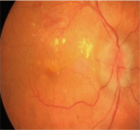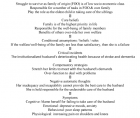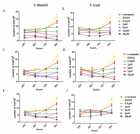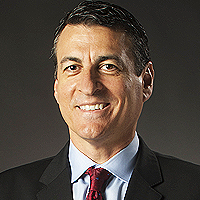Abstract
Research Article
Correlation between the presence of maternal gestational or pre-gestational pathologies and hearing impairment in the puerperal period
Raphaella Costa Moreira Simen*, Alan Araújo Vieira, Maria Elisa Vieira da Cunha Ramos Miterhof and Armanda de Oliveira Pache de Faria
Published: 22 November, 2019 | Volume 2 - Issue 2 | Pages: 122-126
Objective: To evaluate whether the occurrence of maternal pathologies, mainly Diabetes Mellitus and Hypertensive Syndromes in the gestational or pre-gestational period may be related to hearing impairment in postpartum women.
Methods: Observational, prospective study including 361 puerperal women who had their deliveries at a reference University Hospital for pregnant women with clinical history of risk. Auditory evaluation was performed by Distortion Product Otoaccoustic Emissions (DPOAE) within 14 days after delivery. Measures of central tendency and absolute and relative frequencies were used to describe the sample and the chi-square test and binary logistic regression to assess the correlation among variables. Significance higher than 95% was observed and the study was approved by the Research Ethics Committee.
Results: A total of 361 postpartum women were studied and 7.5% had hearing impairment. The frequency of gestational hypertension was 13.9%, that of gestational diabetes was 8.6% and that of pre-pregnancy diabetes mellitus was 5.8%. The presence of hearing impairment was significantly correlated with the occurrence of pre-pregnancy diabetes mellitus (OR: 4.5 - CI: 1.51-1.47), and maternal age greater than 29 years (OR: 3.72 - 1, 58-8.76); A correlation was also found between maternal age and the presence of pre-pregnancy diabetes mellitus (OR: 3.84 - CI: 1.45-10.15).
Conclusion: In the population of postpartum women evaluated, having Diabetes Mellitus prior to pregnancy and belonging to the age group older than 29 years increases the chance of having hearing loss.
Read Full Article HTML DOI: 10.29328/journal.cjog.1001033 Cite this Article Read Full Article PDF
Keywords:
Hearing loss; Diabetes mellitus; Gestational diabetes; Postpartum women
References
- Baylan MY, Kuyumcuoglu U, Kale A, Celik Y, Topcu I. Is preeclampsia a new risk factor for cochlear damage and hearing loss? Otol Neurotol. 2010; 31: 1180-1183. PubMed: https://www.ncbi.nlm.nih.gov/pubmed/20657326
- Oh IH, Lee JH, Park DC, Kim M, Chung JH, et al. Hearing loss as a function of aging and Diabetes Mellitus: A Cross Sectional Study. PLoS ONE. 2014; 9: e116161. PubMed: https://www.ncbi.nlm.nih.gov/pubmed/25549095
- Altuntas EE, Yenicesu AGI, Mutlu AE, Muderris S, Cetin M, et al. An evaluation of the effects of hypertension during pregnancy on postpartum hearing as measured by transient-evoked otoacoustic emissions. Acta Otorhinolaryngol Ital. 2012; 32: 31-36. PubMed: https://www.ncbi.nlm.nih.gov/pubmed/22500064
- Selcuk, Terzi H, Turkay U, Kale A, Genc S. Does gestational diabetes result in cochlear damage? J Laryngol Otol. 2014; 128: 961-965. PubMed: https://www.ncbi.nlm.nih.gov/pubmed/25399828
- Brant LJ, Gordon-Salant S, Pearson JD, Klein LL, Morrell CH, et al. Risk factors related to age-associated hearing loss in the speech frequencies. J Am Acad Audiol. 1996; 7: 152-160. PubMed: https://www.ncbi.nlm.nih.gov/pubmed/8780987
- Cilento BW, Norton SJ, Gates GA. The effects of aging and hearing loss on distortion product otoacoustic emissions. Otolaryngol Head Neck Surg. 2003; 129: 382-389. PubMed: https://www.ncbi.nlm.nih.gov/pubmed/14574293
- Abdala C, Dhar S. Maturation and Aging of the Human Cochlea: A View through the DPOAE Looking Glass. J Assoc Res Otolaryngol. 2012; 13: 403-421. PubMed: https://www.ncbi.nlm.nih.gov/pubmed/22476702
- Bakhshaee M, Hassanzadeh M, Nourizadeh N, Karimi E, Moghiman T, et al. Hearing impairment in pregnancy toxemia. Otolaryngol Head Neck Surg. 2008; 139: 298-300. PubMed: https://www.ncbi.nlm.nih.gov/pubmed/18656733
- Linssen AM, van Boxtel MP, Joore MA, Anteunis LJ. Predictors of Hearing Acuity: cross sectional and Longitudinal analysis. J Gerontol A Biol Med Sci. 2014; 69: 759-765. PubMed: https://www.ncbi.nlm.nih.gov/pubmed/24149430
- Jáuregui-Renaud K. Diabetes mellitus in the inner ear. Eur J Pharm Med Res.2016; 3: 17-22.
- Hou Y, Xiao X, Ren J, Wang Y, Zhao F. Auditory Impairment in Young Type 1 Diabetics. Arch Med Res. 2015; 46: 539-545. PubMed: https://www.ncbi.nlm.nih.gov/pubmed/26385484
- Lasagni A, Giordano P, Lacilla M, Raviolo A, Trento M, et al. Cochlear, auditory brainstem responses in Type 1 diabetes: relationship with metabolic variables and diabetic complications. Diabet Med. 2016; 33: 1260-1267. PubMed: https://www.ncbi.nlm.nih.gov/pubmed/26605750
- Jacob TA, Soares LR, Santos MR, et al. Gestacional Diabetes Mellitus: a literature review. Braz J Surg Clin Res. 2014; 6: 33-37.
- Esparza CM, Jáuregui-Renaud K, Morelos CM, Muhl GE, Mendez MN, et al. Systemic high blood pressure and inner ear dysfunction: a preliminary study. Clin Otolaryngol. 2007; 32: 173-178. PubMed: https://www.ncbi.nlm.nih.gov/pubmed/17550504
- Soares MA, Sanches SG, Matas CG, Samelli AG. The audiological profile of adults with and without hypertension. Clinics. 2016; 71: 187-192. PubMed: https://www.ncbi.nlm.nih.gov/pubmed/27166767
- Hull RH, Kerschen SR. The influence of cardiovascular health on peripheral and central auditory function in adults: a research review. Am J Audiol. 2010; 19: 9-16. PubMed: https://www.ncbi.nlm.nih.gov/pubmed/20538964
- Lisowska G, Namysowski G, Morawski K, Strojek K. Early identification of hearing impairment in patients with type 1 diabetes mellitus. Otol Neurotol. 2001; 22: 316-320. PubMed: https://www.ncbi.nlm.nih.gov/pubmed/11347633
- Dayem SM Abd El, Ghany SM Abd El, Beshr Amal E, Hassan AG, Attaya MS. Assessment of hearing in children with type 1 diabetes mellitus. J Pediatr Endocrinol Metab. 2014; 27: 393-402. PubMed: https://www.ncbi.nlm.nih.gov/pubmed/24572980
- Kim MB, Zhang Y, Chang Y, Ryu S, Choi Y, et al. Diabetes mellitus and the incidence of hearing loss: a cohort study. Int J Epidemiol. 2017; 46: 717-726. PubMed: https://www.ncbi.nlm.nih.gov/pubmed/27818377
- Iser BPM, Stopa SR, Chueiri PS, et al. Prevalence of self-reported diabetes in Brazil: results from the National Health Survey 2013. Epidemiol Serv Saude. 2015; 24: 305-314.
- Milech A, Oliveira JEP, Vencio S, et al. Basic Principles, Evaluation and Diagnosis of Diabetes Mellitus. In Guidelines of the Brazilian Society of Diabetes (2015-2016). São Paulo; AC Farmacêutica. 2016; 1-122.
- Ministry of Health. Health Surveillance Systems. VIGITEL: Surveillance of Risk Factors and Protection for Chronic Diseases by Telephone Survey. 2013.
- Structure by age and gender of the disabled population. IBGE 2010 Population Census - General characteristics of population, religion and persons with disabilities.
- Engdahl B. Otoacoustic emissions in the general adult population of Nord-Trondelag, Norway: I. Distributions by age, gender, and ear side. Int J Audiol. 2002; 41: 64-77. PubMed: https://www.ncbi.nlm.nih.gov/pubmed/12467372
- Bonfils P, Bertrand Y, Uziel A. Evoked Otoacoustic Emissions: normative data and presbycusis. Audiology.1988; 27: 27-35. PubMed: https://www.ncbi.nlm.nih.gov/pubmed/3377724
- Collet L, Moulin A, Gartner M, Morgon A. Age-related changes in evoked otoacoustic emissions. Ann Otol Rhinol Laryngol. 1990; 99: 993-997. PubMed: https://www.ncbi.nlm.nih.gov/pubmed/2244732
- Bittar RSM, Sanchez TG, Santoro PP, et al. Glucose metabolism and inner ear. Int Arch Otorhinolaryngology. 1998; 2: 39-4
Figures:
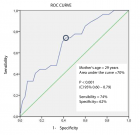
Figure 1
Similar Articles
-
Screening of Gestational diabetes mellitusGehan Farid*,Sarah Rabie Ali*,Reem Mohammed Kamal. Screening of Gestational diabetes mellitus . . 2018 doi: 10.29328/journal.cjog.1001003; 1: 014-023
-
Maternal and fetal outcome of comparative study between old & adopted new value of screening of Gestational Diabetes Mellitus in tertiary centre in Saudi ArabiaGehan Farid*,Reem Mohammed Kamal*,Mohamed AH Swaraldahab,Sarah Rabie Ali. Maternal and fetal outcome of comparative study between old & adopted new value of screening of Gestational Diabetes Mellitus in tertiary centre in Saudi Arabia. . 2018 doi: 10.29328/journal.cjog.1001005; 1: 026-034
-
Correlation between the presence of maternal gestational or pre-gestational pathologies and hearing impairment in the puerperal periodRaphaella Costa Moreira Simen*,Alan Araújo Vieira,Maria Elisa Vieira da Cunha Ramos Miterhof,Armanda de Oliveira Pache de Faria. Correlation between the presence of maternal gestational or pre-gestational pathologies and hearing impairment in the puerperal period. . 2019 doi: 10.29328/journal.cjog.1001033; 2: 122-126
-
Decline in human sperm parameters: How to stop?Aboubakr Mohamed Elnashar*. Decline in human sperm parameters: How to stop?. . 2023 doi: 10.29328/journal.cjog.1001122; 6: 016-020
-
Racial and Ethnic Disparities in Pregnancy-related Complications: Findings at Mansa General Hospital and 2nd Affiliated Hospital of Nanjing Medical UniversityKasonde Chanda, Liang Sheng Lian, Kong Yi Yan, Huang Qian, Gulidiya Abulikem, Royd Nkalamo Nonde, Ying Xiao Yan*. Racial and Ethnic Disparities in Pregnancy-related Complications: Findings at Mansa General Hospital and 2nd Affiliated Hospital of Nanjing Medical University. . 2023 doi: 10.29328/journal.cjog.1001131; 6: 065-075
-
Antioxidants and Pregnancy Complications: Exploring Therapeutic Strategies for Better OutcomesEmmanuel Ifeanyi Obeagu*. Antioxidants and Pregnancy Complications: Exploring Therapeutic Strategies for Better Outcomes. . 2024 doi: 10.29328/journal.cjog.1001155; 7: 001-006
-
Linagliptin Efficacy on Hyperglycemia, Oxidative Stress, and Inflammation in Gestational Diabetes MellitusFolasade Omobolanle Ajao*, Oluwatobi Olayiwola Yusuf, Damilola Ayodeji Balogun, Marcus Olaoye Iyedupe, Mariam Olayinka Adesola, George Adetomiwa Egunjobi. Linagliptin Efficacy on Hyperglycemia, Oxidative Stress, and Inflammation in Gestational Diabetes Mellitus. . 2024 doi: 10.29328/journal.cjog.1001171; 7: 093-099
Recently Viewed
-
Sinonasal Myxoma Extending into the Orbit in a 4-Year Old: A Case PresentationJulian A Purrinos*, Ramzi Younis. Sinonasal Myxoma Extending into the Orbit in a 4-Year Old: A Case Presentation. Arch Case Rep. 2024: doi: 10.29328/journal.acr.1001099; 8: 075-077
-
Current childhood cancer survivor long-term follow-up practices in South AfricaAnel van Zyl*,Mariana Kruger,Paul C Rogers. Current childhood cancer survivor long-term follow-up practices in South Africa. J Adv Pediatr Child Health. 2020: doi: 10.29328/journal.japch.1001008; 3: 001-007
-
Aripiprazole-induced seizures in children with autism spectrum disorder and epilepsyMohammed MS Jan*. Aripiprazole-induced seizures in children with autism spectrum disorder and epilepsy. J Adv Pediatr Child Health. 2020: doi: 10.29328/journal.japch.1001009; 3: 008-010
-
Case-based education to improve learning and faculty teaching of residents and students in a clinical settingDiane E Lorant*,Elizabeth A Wetzel. Case-based education to improve learning and faculty teaching of residents and students in a clinical setting. J Adv Pediatr Child Health. 2020: doi: 10.29328/journal.japch.1001010; 3: 011-015
-
“Syndrome of Contractures and Deformities” according Prof. Hans Mau. Symptoms, diagnosis, treatment: Recommendations for parentsTomasz Karski*,Jacek Karski. “Syndrome of Contractures and Deformities” according Prof. Hans Mau. Symptoms, diagnosis, treatment: Recommendations for parents. J Adv Pediatr Child Health. 2020: doi: 10.29328/journal.japch.1001012; 3: 021-023
Most Viewed
-
Evaluation of Biostimulants Based on Recovered Protein Hydrolysates from Animal By-products as Plant Growth EnhancersH Pérez-Aguilar*, M Lacruz-Asaro, F Arán-Ais. Evaluation of Biostimulants Based on Recovered Protein Hydrolysates from Animal By-products as Plant Growth Enhancers. J Plant Sci Phytopathol. 2023 doi: 10.29328/journal.jpsp.1001104; 7: 042-047
-
Sinonasal Myxoma Extending into the Orbit in a 4-Year Old: A Case PresentationJulian A Purrinos*, Ramzi Younis. Sinonasal Myxoma Extending into the Orbit in a 4-Year Old: A Case Presentation. Arch Case Rep. 2024 doi: 10.29328/journal.acr.1001099; 8: 075-077
-
Feasibility study of magnetic sensing for detecting single-neuron action potentialsDenis Tonini,Kai Wu,Renata Saha,Jian-Ping Wang*. Feasibility study of magnetic sensing for detecting single-neuron action potentials. Ann Biomed Sci Eng. 2022 doi: 10.29328/journal.abse.1001018; 6: 019-029
-
Pediatric Dysgerminoma: Unveiling a Rare Ovarian TumorFaten Limaiem*, Khalil Saffar, Ahmed Halouani. Pediatric Dysgerminoma: Unveiling a Rare Ovarian Tumor. Arch Case Rep. 2024 doi: 10.29328/journal.acr.1001087; 8: 010-013
-
Physical activity can change the physiological and psychological circumstances during COVID-19 pandemic: A narrative reviewKhashayar Maroufi*. Physical activity can change the physiological and psychological circumstances during COVID-19 pandemic: A narrative review. J Sports Med Ther. 2021 doi: 10.29328/journal.jsmt.1001051; 6: 001-007

HSPI: We're glad you're here. Please click "create a new Query" if you are a new visitor to our website and need further information from us.
If you are already a member of our network and need to keep track of any developments regarding a question you have already submitted, click "take me to my Query."







